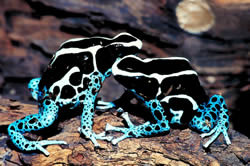Life Cycle : Tadpoles Become Frogs

Overview
This resource is a Science student activity that utilizes Utah's Online Library resources - specifically, Gale's Kids InfoBits, Digital Science Online, and World Book Encyclopedia - to help students learn about the life cycles of frogs.
About Utah's Online Library
Utah's Online Library provides Utah educators and students free access to high-quality reference collections such as EBSCO, Gale Reference Collection, World Book, eMedia, and LearningExpress Library.
This activity was designed to help educators utilize this amazing resource in their classrooms.
Note: Utah educators and students visiting Utah's Online Library from a school computer should be automatically authenticated. When at home, students must use the home access login that their teacher or school media specialist can provide. Utah educators can use either their my.uen login or the home access login.
Activity
Essential Question: How do frogs change and grow? How do organisms change as they go through their life cycles?
It's always interesting for students to explore the life cycle of insects, amphibians, reptiles, and mammals. The life cycle of frogs offers students a pattern for life cycles of amphibians. The databases in Utah's Online Library have many resources that offer students frog and tadpole content at their own reading level.
Frogs are amphibians. The word amphibian literally means "double life" which is an indicator of their life cycle. They begin their life as water creatures (tadpoles) and then change into land-dwelling frogs. Frogs are vertebrates which means that they have a backbone. They are cold-blooded.
After female frog eggs are fertilized, they are called spawn. They are surrounded by a jelly-like substance to protect them. Most eggs are laid in water so that they can stay moist. Inside the eggs, the frog embryos grow and develop into tadpoles. When the eggs hatch, the tiny tadpoles float off into the water. Like fish, they are able to breathe underwater through gills. At first, the tadpoles cannot swim because their tails are not developed. So they hide at the bottom of their watery area to avoid predators. Within a few days, they have grown tails and can swim and eat and grow larger. As the tadpole grows, its tail eventually disappears, and long legs develop in the back of the tadpole and then shorter legs in the front. The gills of the tadpole are soon replaced by lungs so that it can breathe on land. Its mouth grows larger, and it develops a long tongue. Its life cycle is complete, and it is a frog!
Frogs live on every continent except Antarctica.
Besides life cycle information, students may want to become frog explorers and research different kinds of worldwide frogs. Gale's Kids InfoBits Grades K-6 has information about small, colorful, Amazonian poisonous tree frogs as well as enormous African frogs. Students could create Venn diagrams comparing 2 frogs from different parts of the world. For example, the Goliath frog which lives in Africa is 12 inches long and weighs 7 pounds. The Gold frog which lives in Brazil is about ½ inch long.
Students can use presentation-type tools such as PowerPoint, Glogster, Prezi, etc. to create short presentations about the types of adaptations that help frogs be successful in their particular environment. For example, frogs in hot desert areas often dig into the sand and bury themselves to avoid daytime temperatures. Most frogs have large eyes, and the placement of their eyes on top of their head helps them find food and more easily see predators. The long legs of frogs help them jump long lengths in order to catch flying insects as well as escape from predators.
Have students use their research skills to locate information about the difference between a frog and a toad.
Gale's Kids InfoBits Grades K-6 contains 20 pictures, more than 1,100 magazine articles, and frog information excerpted from over 70 books. Digital Science Online has a video series about amphibians (from the menus on the left, choose Primary for the grade level and then choose Life Science to see the available videos). Digital Science Online is also available in Spanish. World Book Encyclopedia has audio files of croaking frogs as well as short video clips in addition to encyclopedia information.
Curriculum Connections: